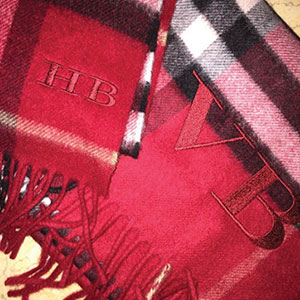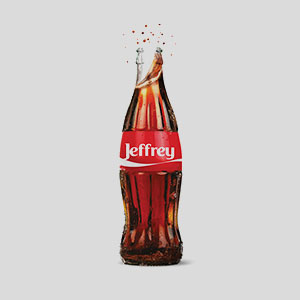Product Hub July 03, 2015
Getting Personal
Large retail brands have embraced the personalization trend, thanks to software that makes mass customization both scalable and profitable. Already firmly ensconced in the world of custom apparel, decorators can still learn from their example.
What’s better than a hat bearing your favorite sports team’s logo? How about that same cap with your name emblazoned across the back? Or perhaps the years the team won a championship embroidered on the side? A mall fixture, LIDS has become almost synonymous with the idea of retail personalization – its customers tempted away from their department store destinations by the novelty of having their initials stitched for posterity onto one of 14,000 hat styles. Kent Haffner, director of retail customization for LIDS Sports Group, likens the whir of the embroidery machine – strategically planted in the front of each shop – to the irresistible aroma of gourmet cookies or buttered popcorn at other specialty mall stores.“It’s a form of retail entertainment,” he explains.“The customers can see what’s going on here. That’s kind of our draw to get them in the stores.”
It’s a strategy that seems to be working. LIDS launched in-store, while-you-wait embroidery at 12 locations in the early 2000s. Now, the sports apparel giant has embroidery services in the vast majority of its stores, and custom jerseys available in 121 locations.“We take your order, and 15 to 20 minutes later, you walk out with your customized cap,” Haffner says, adding that it’s what sets LIDS apart from competitors.“Even in locations that don’t have embroidery, customers are coming in and asking for it.”
Consumers who expect lightning-quick delivery and the ability to put their stamp on any product aren’t just a LIDS phenomenon. Anywhere you look, customization is king: from personalized soda bottles to sneakers tricked-out with Instagram pics.“People want to stand out and be distinct,” says JP Hunt, vice president of InkSoft, which creates e-commerce and design software for decorators. Technological advances of the last few years have allowed them to do just that. Mass customization is not only possible, but has become very profitable, and retail brands have been quick to latch on.
Apparel decorators, of course, are no strangers to custom work, and are in an ideal position to benefit from this ubiquitous trend. But those who haven’t invested in an e-commerce solution with an interactive online design component or software that enables streamlined, scalable, error-free personalization could be left in the dust.“Customers have these expectations that they should be able to interact with a website,” Hunt says.“That expectation is increased when you’re a printing business. If they can’t see the products you offer and can’t put a design onto it, that’s a real misalignment.”
Decorators should be mirroring what retailers are doing, to stay competitive in an increasingly me-centric world, according to Hunt and other technology experts.
A Simple Solution
As a mall store with a high employee turnover rate, LIDS is in a different situation than many custom embroidery shops out there, and Haffner says his company needed a software solution that acknowledged those differences. In the early days of customization, LIDS was using a fairly complex digitizing program, and training was a big challenge. The company turned to Pulse Microsystems to create a template-based program for embroidery design.“They want to make sure that it doesn’t matter what store you walk into, you’re going to walk out with the same quality hat,” says Brian Goldberg, Pulse president.
Thanks to the customized, intuitive software, LIDS has been able to cut down employee training by a whole day, Haffner says.“Most employees can come in and click, click, click to create a design fairly simply. … It helps with efficiency.”
Though that program was specifically tailored to LIDS’ needs, Pulse offers a retail embroidery solution for other shops called Autograph. The idea is to give lower-level, transitional staff the ability to create error-free artwork with very little training, Goldberg says.“It’s not as free-ranging as a general-purpose embroidery system,” he adds.“You’re restricted in what you can do intentionally. … [Autograph] allows the retailer to choose what templates the staff person is going to be able to use. They’re controlling the results and getting consistent results.”
Name-Checked Fashion
Stepping out of the mall and onto the runway, personalization remains paramount. Last year, rag & bone sent its models down the catwalk in varsity jackets with their own names stitched in looping ’50s-style letters across the back. Fashion bloggers salivated over that custom flourish in the greaser-chic collection, and for a limited time, rag & bone replicated the runway look for customers, embroidering names of up to seven letters on women’s jackets, men’s bowling shirts and other select items.
“I think people have so much control over various aspects of their lives right now. Everyone is living in the public eye.”
Meredith Finkelstein, Print All Over Me
Adding a monogram or name to a high-end garment evokes a special sort of feeling, says Marcus Andrews, creator of the M Andrews Sartorial Luxury Collection, a custom menswear brand in San Antonio, TX. His company sells cut-to-order suits and shirts, and nearly every customer opts to add a monogram to the dress shirts they purchase.“It’s like a visual confirmation that they have something made just for them,” Andrews says.
Not to get too philosophical, but what’s in a name? For luxury fashion brand Burberry, the answer is $100. That’s about how much the designer tacks onto the bill when online customers add a three-letter monogram to one of its signature scarves.“I think most of our customers would die for that kind of margin,” Goldberg says. Pulse designed Burberry’s online personalization engine, offering customers a simple, clean way to add a touch of customization – their initials stitched in the font and thread color of Burberry’s choosing – without diluting or cheapening the brand.
Burberry, trading on its high-end reputation, may be an exception when it comes to profit margins for personalization, but done right, adding a monogram or name to a garment is high margin for any decorator.“You’re putting three letters on a garment for a customer willing to pay $10 to $20 for something that costs you hopefully very little,” Goldberg says.

The trick when it comes to affordable personalization, he adds, has been scale.“The problem that larger manufacturers faced in the past was if they had double the number of personalization orders, they needed double the number of machines and staff,” he adds.“That’s not scale. Proportional growth in expenses is not a way to make money.” Pulse solved that issue for Burberry and other brands with its automation software PulseID, which eliminates the need for manual order entry and machine setup.“I think that’s sort of the magic potion that they were looking for. … We’ve seen a massive reduction in labor costs because operators are handling more machines now and are able to produce more on those machines,” he adds.
Say My Name

Mass-market retailers have latched onto the idea that people want to stand out and feel special. From shoes to soda, the list of consumer goods that include the option for personalization continues to grow.
Sharing Success: Last summer, Coca-Cola ran a popular“Share a Coke” campaign, manufacturing a limited run of coke bottles, bearing people’s names on the iconic red-and-white labels. The company is expanding the marketing ploy this year. In addition to sending bottles bearing 1,000 of the most popular names into stores across the country, the company is adding an e-commerce component, allowing consumers with less-common monikers to order personalized 8-ounce bottles online at shareacoke.com.
Custom Kicks: The Nike ID site allows consumers to choose colors and designs for each part of the sneaker, from the sole to the lace. Shoppers can add their names or another message to the shoe’s tongue. Adidas took customization a step further last year, when it introduced an application that lets customers use their own Instagram photos to decorate select shoe styles.
In the Bag: Mars hits the sweet spot of personalization with its mymms.com website. Shoppers can choose the base colors of the candy-coated chocolates, adding personal messages, clip art or uploading their own photos to be printed on the beloved candies.
Pop Art: Kellogg’s allows customers to put their photo, along with a special message on certain boxes of Pop-Tarts, cereal and other products, at its online store.
The Custom Web
With the rise of social media, consumers have become accustomed to curating and customizing their online identities.“People have so much control over various aspects of their lives right now,” says entrepreneur Meredith Finkelstein.“Everyone is living in the public eye.” The next step, she adds, is to translate that customer’s online persona into the physical world. That’s the idea behind Print All Over Me (printallover.me), the online apparel company she helped launch a little over a year ago.

Print All Over Me designs the clothing silhouettes and fabrics, and users can upload their own designs and photographs to be digitally printed on fabric, then cut and sewn into the style of their choice.“We’re breaking down the barriers between what it means to be the designer and the consumer,” Finkelstein says.
One of the underpinnings of Print All Over Me’s success is how simple it is. Consumers don’t have to have a lot of technical know-how to feel creative. Tailoring shoppers’ online design experience is often key to increasing e-commerce sales, Goldberg says.“When you provide an open-ended design tool, the closure rate is low because most people aren’t artistic, though they want to be creative,” he adds.“You have to drive that creativity somehow in order to get a successful result.” Pulse uses a template-based system, where end-users make choices, adding their names and editing designs created by professionals with artistic flair.
“I think [personalization is] going to continue to grow in terms of mass media and mass consumer products. People expect it, and they want it. That’s been heard loud and clear.”
JP Hunt, InkSoft
But even truly creative consumers were daunted by the prospect of creating custom clothing before online designers and digital printing blossomed, says Donny Michel, owner of four-year-old, Web-based Smurk Creative Apparel.“Before, it was always the traditional way of ordering – the minimum charges and setup fees – that stopped people,” he says. Artists and band members, he adds, didn’t have the cash flow to order dozens of shirts upfront.“I wanted to disrupt the apparel decorating industry in a good way,” Michel says.
Powered by DecoNetwork, Smurk allows customers, artistic or not, to choose from one of over 1,000 stock templates to edit, or upload art from Facebook and Instagram. The company doesn’t charge setup or minimum fees, printing items on demand and allowing customers to set up online stores featuring their own shirt designs.“They can really do anything and everything from what we offer on our platform,” Michel says.
Online designers can help decorators capture new Web-based customers, like those flocking to companies like Smurk. But a development that has been surprising to some, according to Brenden Prazner, product manager at DecoNetwork, is how much a shop’s existing customers enjoy being able to self-serve via the Web. Sports coaches, for example, love the ability to use online designers to confirm the spelling of players’ names. Encouraging such self-service also lifts some of the burden from the decorator, Prazner adds. Rather than spending 30 minutes to sit down with an indecisive customer in their shop – losing precious time and money – decorators can now direct such clients to their website to experiment.“They can spend as much time as they want, swapping fonts and colors without taking up anyone’s time,” Prazner adds.
Don’t expect the personalization trend to wane anytime soon.“I think it’s going to continue to grow in terms of mass media and mass consumer products,” Hunt says.“People expect it, and they want it. That’s been heard loud and clear.”
Lessons From the Pros
If you plan to add customization options and e-commerce to your shop’s website, here are a few lessons to take away from the pros.
1. Make it easy. Ramin Ramhormozi, creator of Personalization Pop, a personalization hub for online store owners, has been in the e-commerce business since the late 1990s. In the early years, when he offered personalized groom gifts, he was frustrated that technology had not caught up to his needs. Customers then couldn’t easily add unique names and messages to multiple copies of the same item. Rather than filling everything out on one browser page, they had to add the item to the shopping cartindividually, adding significantly to order time. Today, that wouldn’t fly. People want to be able to add their personal touches quickly online or via mobile, without a lot of hassle, and there’s technology out there that makes this possible.“It’s beautiful from a user standpoint how simplistic it is,” Ramhormozi says.
2. Set expectations. If you offer a virtual sample of a monogram or other custom work, make sure it’s a realistic representation, says Brian Goldberg of Pulse Microsystems.“You’re trying to entice the customer to place the order,” he adds.“But now the customer is going to expect the product to look like that.”
3. Don’t overwhelm people with choices. Print All Over Me has a very structured and limited design tool. You upload one design, and decide how large you want the pattern to be. (Think of it like the textile-making challenge on Project Runway.) The rest of the design choices are made on the back end, though company co-founder Meredith Finkelstein says they may add more functionality as users grow more accustomed to using the site.“We didn’t want to offer it all at once,” she says.
4. Customize your own setup.Even smaller shops can benefit from automation and online design tools, experts say. Consider low-entry, subscription-based software models, where you can pull out anytime, rather than making a big up-front investment into software.“We have invested over $10 million in DecoNetwork,” says Brenden Prazner, adding that DecoNetwork’s clients get the benefit of that investment into e-commerce and marketing, without having to make their own significant up-front investment.
Theresa Hegel is a senior staff writer for Stitches. Contact her at thegel@asicentral.com and follow her on Twitter at @TheresaHegel.

Product Hub
Find the latest in quality products, must-know trends and fresh ideas for upcoming end-buyer campaigns.
